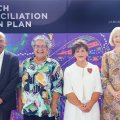Latest data available for the "big six" PhD-granting institutions shows that the University of Queensland is one of the top two Australian universities for PhD completions.
In 1997, 311 students graduated with PhDs at UQ, compared with 300 in 1996 and 224 in 1995.
According to the University's Dean of Postgraduate Students, Associate Professor Alan Lawson, the figure confirms UQ's place as one of Australia's principal postgraduate training centres.
1997 figures for the main Australian PhD granting institutions are: University of Sydney, 340 PhD completions; University of Queensland, 311; University of Melbourne, 301; University of New South Wales 282; Monash, 244; and Australian National University 225.
Dr Lawson said the average completion time from enrolment to submission of PhD theses was three years and seven months - an excellent result. He said he believed the key to the University's success in attracting and graduating so many postgraduate students lay in its superior facilities, learning opportunities and effective supervision.
"The University has excellent intellectual and physical resources to support postgraduate research and the development of the Graduate School this year is expanding that focus," he said.
"Ours is a very strong university in terms of research. We are first or second among Australia's 37 universities in almost every performance indicator and because postgraduate studies are fostered by nodes of active research we naturally attract excellent postgraduate students and foster high-level postgraduate work.
"We also have very strong collaborative relations with industry in our research and UQ tops the nation in industry-funded research. That means industry-oriented opportunities for research students to carry out PhD and masters research.
"In 1996, the Postgraduate Research Studies Committee developed a comprehensive policy on the role and responsibilities of supervisors of research higher degree students. And in 1997 the Committee established guidelines for departmental management and infrastructure needs of postgraduate students."
Dr Lawson said the development of University policy on infrastructure support for research provided a public and explicit statement of the minimum resources that the University believed should be provided and was intended to serve as a guide to further developments in departments and schools. A 1996 survey revealed that infrastructure resources were generally more than adequate.
"Completion rate, submission time and satisfaction with the graduate research program are closely related to the quality of infrastructure facilities that could be provided," Dr Lawson said.
He said the University also continued to fund HECS exemptions for all research higher degree students and allocated around $4.3 million to fund University of Queensland Postgraduate Research Scholarships (UQPRS) for new and continuing students. To mark the announcement of the University of Queensland as University of the Year 1998, the Graduate School this month announced three new scholarship schemes to assist PhD students.
Dr Lawson said the University was constantly looking for new ways to improve the service offered to prospective and existing postgraduate students and had developed a detailed prospectus outlining for potential students exactly what the University offers in its PhD and research masters programs.
The University's Graduate School was developing value-adding training workshops in areas such as research skills, information retrieval, writing skills, oral presentation, publishing skills, identifying prospective employment opportunities, and writing grant applications.
Dr Lawson said the University of Queensland's reputation as a postgraduate and research institution was such that it figured in the top two or three nationally in all performance indicators.
"A large number of Australian and international students come here because of this to complete their masters and PhDs," he said.
"They are also impressed by the peer rankings that have nominated the University of Queensland as having the number one departments in Australia in a broad range of disciplines."
Overseas students were well represented in both PhD completions and the proportions of postgraduate students engaged in PhD studies. Dr Lawson said 78 (21.4 percent) of the 365 students who submitted PhDs in 1997 were international students.
"This figure is higher than the 15 percent of total PhD students who are international students so their performance and contribution to the University's research program is outstanding," he said.
"The proportion of international students in the PhD program is much higher than the proportions of international students in undergraduate courses. Many of these PhD students come from South-East Asia."
In second semester 1998, the number of new international PhD students was more than double the number who commenced at the same time last year. In 1997 the University's total 5780 postgraduate population included 2258 PhDs, 650 research masters and 1576 coursework masters students. The number of research higher degree students increased by 240 percent in 10 years.
For more information, contact Dr Lawson on (07) 3365 3477.



